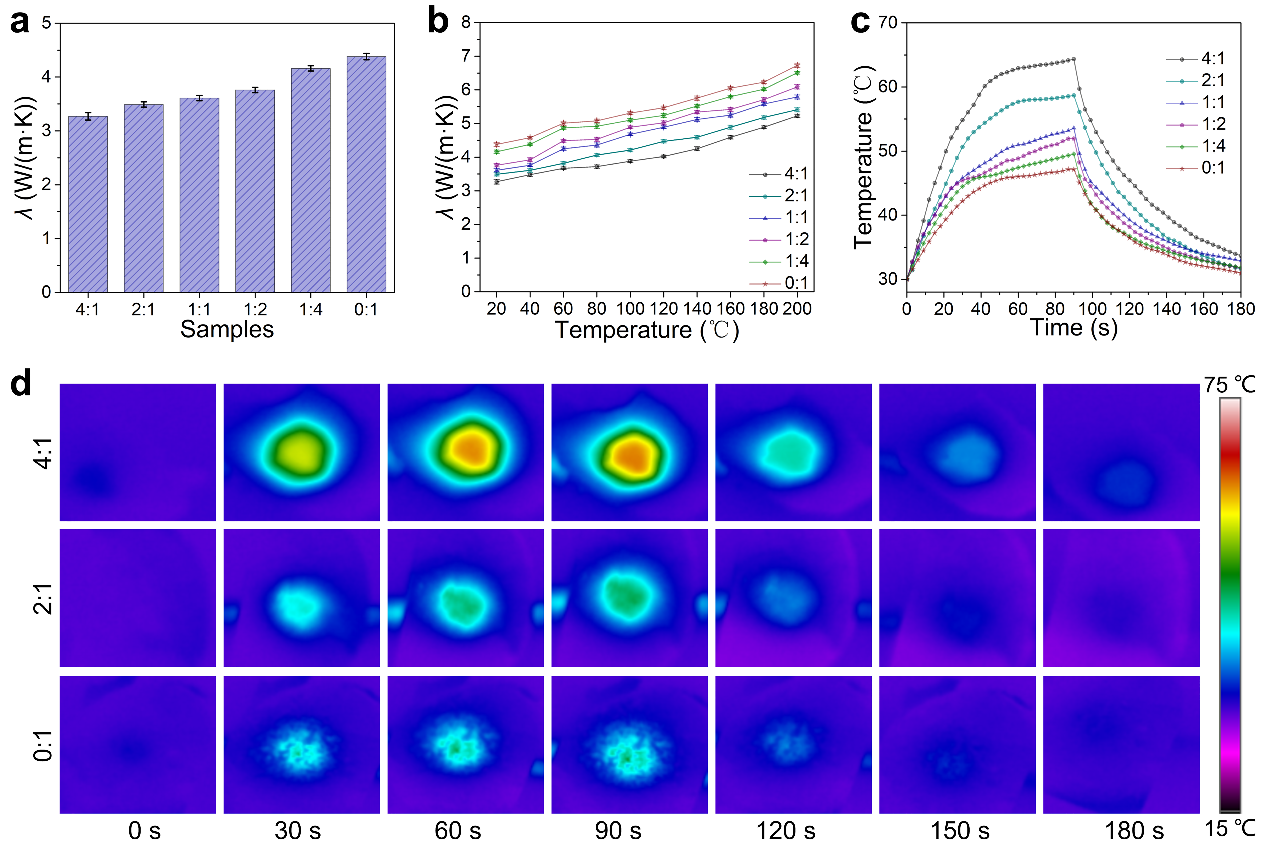随着航空航天武器装备、高精密度智能控制系统和第五代移动通讯技术终端与基站等电子和电气技术的高速发展,电子电气设备及元器件工作时产生的热量急速积聚,不可避免地导致电子产品及其元器件出现局部过热问题,影响电子设备及其元器件的运行性能、寿命和可靠性;由此产生的电磁波辐射还会干扰周围设备及元器件的正常运行,对周边人员(尤其是作业人员)的身体健康造成威胁,并对外界造成不可忽视的电磁波污染。因此,设计研发导热/电磁屏蔽一体化高分子复合材料对于解决其导热/电磁污染问题势在必行。
西北工业大学化学与化工学院顾军渭教授“结构/功能高分子复合材料”(SFPC)课题组团队以聚酰亚胺(PI)为基体、聚甲基丙烯酸甲酯(PMMA)微球为模板,采用“静电纺丝-真空辅助抽滤-铺层热压-热处理”工艺制备Ti3C2Tx中空微球孔径和分布可控的柔性(Fe3O4/PI)–Ti3C2Tx–(Fe3O4/PI)复合膜。多孔/多层结构的可控设计可以有效增强界面极化,促进电磁波多次反射,协同提升其力学性能和电磁屏蔽性能。当Ti3C2Tx中空微球的孔径为10 μm且PMMA/Ti3C2Tx质量比为2:1时,(Fe3O4/PI)–Ti3C2Tx–(Fe3O4/PI)复合膜具有最佳的电磁屏蔽效能(85 dB)。有限元模拟进一步验证了该复合膜对电磁波具有最优的屏蔽效果。复合膜还兼具优良的导热性能(导热系数为3.49 W/(m·K))和力学性能(拉伸强度为65.3 MPa)。这种兼具优异电磁屏蔽性能、导热性能和力学性能的柔性(Fe3O4/PI)–Ti3C2Tx–(Fe3O4/PI)复合膜在大功率化、便携化以及可穿戴化柔性电子设备的电磁屏蔽防护领域具有广阔的应用前景。

Figure 1. a) Schematic illustration for fabricating the (Fe3O4/PI)–Ti3C2Tx–(Fe3O4/PI) composite film. Characterization results of the PMMA microsphere, the Ti3C2Tx, the PMMA@Ti3C2Tx microsphere, and the Ti3C2Tx hollow microsphere: b) the XRD patterns, c) the XPS full spectra, and the high-resolution XPS narrow spectra of d) Ti 2p and e) C 1s.

Figure 2. Morphology of the PMMA microspheres, the PMMA@Ti3C2Tx microspheres, and the Ti3C2Tx hollow microspheres: the SEM images and the corresponding EDS element distribution diagrams of the C and Ti elements of a) the PMMA microspheres, b) the PMMA@Ti3C2Tx microspheres, and c) the Ti3C2Tx hollow microspheres; d) the TEM image of the Ti3C2Tx hollow microspheres; e) the SEM images of Ti3C2Tx hollow microspheres after deliberate breaking for observing the wall thickness.

Figure 3. Morphology of the Fe3O4/PAA electrospun nanofiber films, the (Fe3O4/PI)–PMMA@Ti3C2Tx–(Fe3O4/PI) composite films with different diameters, and the corresponding (Fe3O4/PI)–Ti3C2Tx–(Fe3O4/PI) composite films: a) the SEM images of the surface of the Fe3O4/PAA electrospun nanofiber films; the cross-sectional SEM images of b) the (Fe3O4/PI)–PMMA@Ti3C2Tx–(Fe3O4/PI) composite films with the diameter of 5 μm and c) the corresponding (Fe3O4/PI)–Ti3C2Tx–(Fe3O4/PI) composite films (attached with the EDS element distribution diagrams of the Fe and Ti elements); the cross-sectional SEM images of d–f) the (Fe3O4/PI)–PMMA@Ti3C2Tx–(Fe3O4/PI) composite films with diameters of 10 μm, 15 μm, and 20 μm, and g–i) the corresponding (Fe3O4/PI)–Ti3C2Tx–(Fe3O4/PI) composite films.

Figure 4. Morphology of (Fe3O4/PI)–Ti3C2Tx–(Fe3O4/PI) composite films based on different mass ratios of PMMA/Ti3C2Tx: the cross-sectional SEM images of (Fe3O4/PI)–Ti3C2Tx–(Fe3O4/PI) composite films prepared with the mass ratios of PMMA/Ti3C2Tx of a) 4:1, b) 2:1, c) 1:1, d) 1:2, e) 1:4, and f) 0:1.

Figure 5. Electromagnetic interference shielding performances of the (Fe3O4/PI)–Ti3C2Tx–(Fe3O4/PI) composite films with different mass ratios of PMMA/Ti3C2Tx: a) the SET, b) the SEA, and c) the SER; d) the energy density distribution and e) the electric field intensity and the energy flow of the (Fe3O4/PI)–Ti3C2Tx–(Fe3O4/PI) composite films based on the mass ratios of PMMA/Ti3C2Tx of 4:1, 2:1, 1:2, and 0:1 (from left to right); f) the schematic illustration of the EMI shielding mechanism; g) the EMI SE of the (Fe3O4/PI)–Ti3C2Tx–(Fe3O4/PI) composite films before and after being placed for 30 days without vacuum protection; h) the comparison of the EMI SE vs. thickness of the (Fe3O4/PI)–Ti3C2Tx–(Fe3O4/PI) composite films and other works; i) the photos showing the EMI shielding effect of the (Fe3O4/PI)–Ti3C2Tx–(Fe3O4/PI) composite films between a wireless charger and a smartphone.

Figure 6. Thermal conductivity of (Fe3O4/PI)–Ti3C2Tx–(Fe3O4/PI) composite films: λ values of (Fe3O4/PI)–Ti3C2Tx–(Fe3O4/PI) composite films which are a) based on different mass ratios of PMMA/Ti3C2Tx and b) under different temperatures; c) the surface temperatures and d) the corresponding infrared thermal images of the (Fe3O4/PI)–Ti3C2Tx–(Fe3O4/PI) composite films.
本工作近期以“Controlled Distributed Ti3C2Tx Hollow Microspheres on Thermally Conductive Polyimide Composite Films for Excellent Electromagnetic Interference Shielding”为题发表于Advanced Materials(2023, 10.1002/adma.202211642)上。第一作者为西北工业大学化学与化工学院博士生张雅莉,通讯作者为西北工业大学化学与化工学院顾军渭教授和新加坡南洋理工大学周琨教授。本研究工作得到了国家自然科学基金(U21A2093和51903173)、XXX技术基础重点项目、中央高校基本科研业务费资助项目、西北工业大学博士论文创新基金(CX2021107和CX2022073)以及高分子电磁功能材料陕西省“三秦学者”创新团队的资助和支持。
论文信息:Yali Zhang, Kunpeng Ruan, Kun Zhou* and Junwei Gu*. Controlled Distributed Ti3C2Tx Hollow Microspheres on Thermally Conductive Polyimide Composite Films for Excellent Electromagnetic Interference Shielding. Advanced Materials, 2023, 10.1002/adma.202211642.
原文链接:https://doi.org/10.1002/adma.202211642
作者简介:

顾军渭,西北工业大学化学与化工学院教授、博导,中国复合材料学会青年科学家奖获得者、陕西省杰出青年科学基金获得者。当选英国皇家化学会Fellow,英国皇家航空学会Fellow,英国材料、矿物与矿业学会Fellow;连续入选科睿唯安全球“高被引科学家”、爱思唯尔“中国高被引学者”。任陕西省高分子科学与技术重点实验室副主任、中国复合材料学会导热复合材料专业委员会常务副主任、中国复合材料学会青年工作委员会副主任委员等。主要从事功能高分子复合材料和纤维增强先进树脂基复合材料的设计制备及加工研究。获陕西省自然科学二等奖(1/5)、中国复合材料学会科学技术奖二等奖(1/8)、高等学校科学研究优秀成果奖(科学技术)技术发明二等奖(2/6)、中国化学会高分子创新论文奖等。主持国家自然科学基金联合基金重点项目、XXX技术基础重点项目、陕西省杰出青年科学基金等省部级及以上项目20余项。以第一和/或通讯作者在Adv Mater, Angew Chem Int Edit, Sci Bull和Macromolecules等期刊发表高水平SCI论文160余篇,学术Google引用21000余次,H因子86。4篇论文入选2018~2020年“中国百篇最具影响国际学术论文” 、1篇论文入选第七届中国科协优秀科技论文、1篇论文入选“领跑者5000-中国精品科技期刊顶尖学术论文”。授权中国/美国发明专利31件;主/参编Elsevier、Wiley出版社专著4部。任Nano-Micro Lett、J Mater Sci Technol、Compos Sci Technol、Natl Sci Rev和中国塑料等多个国内外期刊副主编和编委等。
- 青科大张建明、陈玉伟 ACHM:提出离子液体助推BN电场取向的新策略 - 实现硅橡胶复合材料导热性能提升 2025-12-15
- 南理工傅佳骏教授团队 AM:强韧如贝壳 - 兼具耐湿、室温自修复与高导热性能的仿生纳米复合材料 2025-10-06
- 江苏海洋大学李成杰团队 ACS AMI:可重加工自修复的橡胶基导热界面材料用于热管理 2025-07-20
- 安农大陈玉霞教授团队 AFM: 超薄轻质中空MOF@竹衍生的碳基复合材料 - 用于高效的电磁屏蔽和热管理 2025-09-02
- 武汉纺织大学王栋教授团队 Adv. Sci.:具有低反射特性的异质结构多功能纳米纤维复合膜实现高效电磁屏蔽 2025-08-12
- 四川大学李乙文教授团队 Nat. Commun.:高度有序的黑色素纤维隐形材料实现超高电磁屏蔽比效能 2025-08-05
- 哈工大(深圳)朱时裴教授课题组诚招硕士、博士、博士后 - 材料、化学、物理、机械、生物工程 2025-09-17
